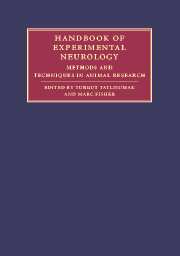Book contents
- Frontmatter
- Contents
- List of contributors
- Part I Principles and general methods
- 1 Introduction: Animal modeling – a precious tool for developing remedies to neurological diseases
- 2 Ethical issues, welfare laws, and regulations
- 3 Housing, feeding, and maintenance of rodents
- 4 Identification of individual animals
- 5 Analgesia, anesthesia, and postoperative care in laboratory animals
- 6 Euthanasia in small animals
- 7 Various surgical procedures in rodents
- 8 Genetically engineered animals
- 9 Imaging in experimental neurology
- 10 Safety in animal facilities
- 11 Behavioral testing in small-animal models: ischemic stroke
- 12 Methods for analyzing brain tissue
- 13 Targeting molecular constructs of cellular function and injury through in vitro and in vivo experimental models
- 14 Neuroimmunology and immune-related neuropathologies
- 15 Animal models of sex differences in non-reproductive brain functions
- 16 The ependymal route for central nervous system gene therapy
- 17 Neural transplantation
- Part II Experimental models of major neurological diseases
- Index
- References
17 - Neural transplantation
Published online by Cambridge University Press: 04 November 2009
- Frontmatter
- Contents
- List of contributors
- Part I Principles and general methods
- 1 Introduction: Animal modeling – a precious tool for developing remedies to neurological diseases
- 2 Ethical issues, welfare laws, and regulations
- 3 Housing, feeding, and maintenance of rodents
- 4 Identification of individual animals
- 5 Analgesia, anesthesia, and postoperative care in laboratory animals
- 6 Euthanasia in small animals
- 7 Various surgical procedures in rodents
- 8 Genetically engineered animals
- 9 Imaging in experimental neurology
- 10 Safety in animal facilities
- 11 Behavioral testing in small-animal models: ischemic stroke
- 12 Methods for analyzing brain tissue
- 13 Targeting molecular constructs of cellular function and injury through in vitro and in vivo experimental models
- 14 Neuroimmunology and immune-related neuropathologies
- 15 Animal models of sex differences in non-reproductive brain functions
- 16 The ependymal route for central nervous system gene therapy
- 17 Neural transplantation
- Part II Experimental models of major neurological diseases
- Index
- References
Summary
Introduction
In spite of early attempts at neural transplantation as long ago as the late nineteenth century, throughout most of the twentieth century it was widely believed that the mammalian brain was relatively fixed and immutable in adulthood, incompatible with receiving and supporting viable transplants. However, at the end of the 1960s, two discoveries challenged this received view: the demonstration that sprouting and reorganization of axons can indeed take place after damage in adult central nervous system (CNS) pathways; and new experimental methods for transplanting nerve cells that were remarkably successful in yielding surviving grafts.
In the first decade after these pioneering studies, attention focused on understanding the basic cellular and developmental biology of neural transplantation in a variety of model systems. Cells were transplanted into the CNS of adult rats using a wide variety of experimental model systems – anterior eye chamber, spinal cord, cerebellum, and diverse forebrain sites including cortex, hypothalamus, striatum, and hippocampus. In the first wave of studies (as illustrated in Fig. 17.1), pieces of neural tissue were implanted into natural cavities such as the anterior chamber of the eye, the brain ventricles or choroidal fissure. In the search for a greater flexibility of graft placement, other studies introduced inoculation of tissue fragments directly into brain parenchyma, although such grafts did not survive well, or the creation of artificial cavities with a rich vascular lining that would nourish newly grafted tissues.
- Type
- Chapter
- Information
- Handbook of Experimental NeurologyMethods and Techniques in Animal Research, pp. 269 - 308Publisher: Cambridge University PressPrint publication year: 2006



